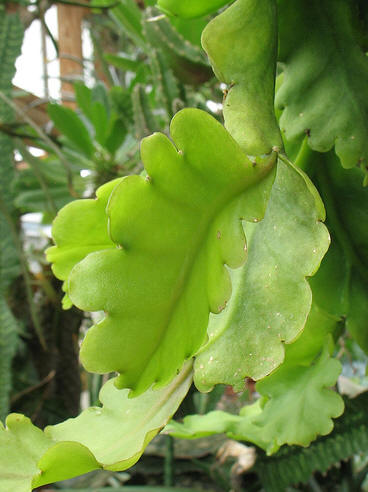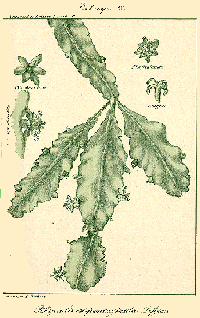R. crispimarginata Loefgren. Arch. Jard. Bot. Rio de Janeiro 2:37. (1918).
From Calvente Thesis 2010 3. RHIPSALIS CRISPIMARGINATA Loefgr., Arch. Jard. Bot. Rio de Janeiro 2: 37. 1917 .TYPE: BRAZIL. Rio de Janeiro: Ilha Grande, 1915, Rose 20401(lectotype in Britton and Rose 1917: US!).
Epiphyte in shaded habitat strictly in forest understory, 1.5-1.8 m long, branching apical or sub-apical. Stem segments flattened in longitudinal section, 0.1-0.5 mm diam, medium green, delicate but flexible, monomorphic, 9-20 cm long, base cylindric to atenuate, apex truncate, attenuate or rounded, wings 2, 1-3 mm, margin serrate to slightly lobed or crenate, undulate, with 3-7 mm projections, midrib 1.5-2.5 mm diam, cylindric to flattened. Areoles between margin projections, 2-3.3 cm apart, first of segment (2.5-)3-7 cm distant from segment base; when sterile 1 mm diam, with vestigial scales; when fertile 1.5 mm diam, with 1-3 acicular scales, 1-2 flowers/fruits. Flowers 12-16 mm diam; pericarpel 3.2-5.7 X 2.3-3.2 mm, cylindric, greenish white, with 1 sepaloid bract near apex; with 3 sepaloid tepals, 0.7-2 mm long and 6-7 petaloid tepals, 3.5-6 X 3-3.5 mm, oblong to elliptic, patent to reflexed, greenish or whitish, apex rounded, slightly cucullate to cucullate, margin straight or curved inwards. Style ca. 4.5 mm long; stigma with 5 lobes, ca. 1.5 mm long, sagitate, erect. Ovules in 5 incomplete septa, funicle short (< 0.5 mm long). Stamens ca. 70, 3.5-6 mm long, internal shorter, internal facing outwards and external facing inwards, white. Nectary 0.7 mm long. Fruit 7-8 X 6-7 mm, ovoid to globoid, pinkish translucent, glabrous. Figure 6: A, G.
Notes; The type material originally proposed for R. crispimarginata by Loefgren (1917) was a material collected at Ilha Grande (Rio de Janeiro) by Loefgren, Rose, and Campos Porto (s.n.). Subsequently, Britton and Rose (1923) cited the collection Rose 20401 from llha Grande as the type of R. crispimarginata. The collection Rose 20401 had duplicates deposited at both US and NY. However, the specimen (Rose 20401) at NY was preserved after cultivation and is excluded from the type material as it is reduced and seems to be juvenile not allowing the correct identification. Furthermore, the illustration for R. crispimarginata presented in Britton and Rose (1923) represents a stouter and apparently stiffer plant that actually resembles R. crispata. Additional specimens at NY labeled as "Shafer by Lofgren" (material in cultivation sent by Lofgren to Shafer) are also distinct from the type specimen.
Barthlott and Taylor (1995) considered R. crispimarginata as a synonym of R. oblonga. However, R. crispimarginata differs from R. oblonga by the larger and wider stem segments with smaller mature areoles and translucent rose fruits, in contrast to the greenish translucent fruits of B. oblonga. Thinner forms of R. crispimarginata can, however, be confused with R. oblonga in the herbarium.
The molecular phylogeny of Calvente et al. (in prep.; Fig. 1) indicated that R. crispimarginata is sister to R. cuneata, both of which share thin and delicate (but flexible) stem segments with narrow-attenuate to almost cylindric base.
Habitat and distribution: Occurs in Rio de Janeiro and Northern Sao Paulo in coastal Atlantic Forest (Brazil). Figure 3.
R. crispimarginata Loefgren. Arch. Jard. Bot. Rio de Janeiro 2:37.(1918). Info from Britton And Rose Reduced to synonymy under R. oblonga by Barthlott and Taylor Bradleya 13
|

